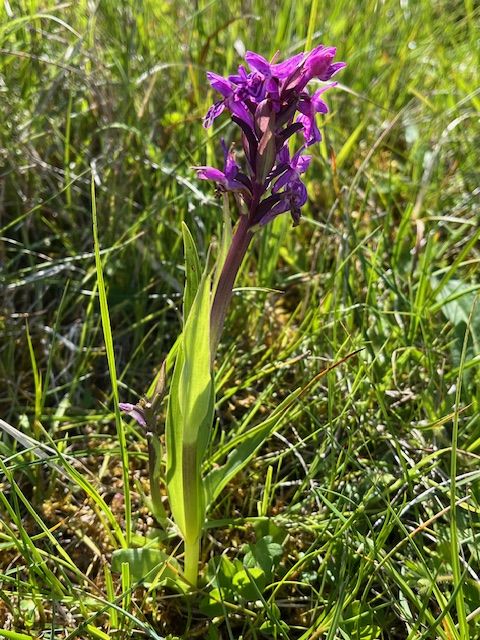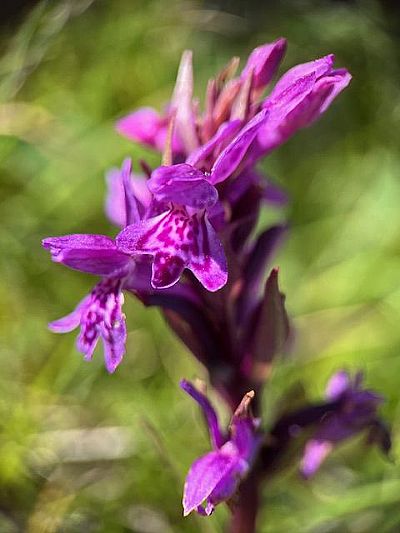Members, please make submissions to info@orkneyu3a.org
u3a Botany Group - 4 June, 2024 - at the Primrose Field, Heddle
by John Crossley & Merryn Dineley - 11:27 on 03 July 2024
We gathered in Finstown on a fine afternoon for a short walk to the now-famous field of primroses below Heddle quarry. The owner of the field, Victor Muir, had very kindly shut the grazing sheep into an adjacent field so they did not spoil our enjoyment of the flowers. The primroses (always ‘Mayflowers’ in Orkney as I had learned from Victor, also from Myrtle) had by now finished flowering but for the odd straggler, but the next flush of early summer flowers had taken their place. And what a variety!
A prelude consisted of the walk up Heddle road, with beautiful gardens, hedges and trees on display, and Robins and Blackbirds singing. Despite these attractions, John Crossley’s attention was drawn to a tiny scruffy weed growing at the pavement edge; it turned out to be Annual Pearlwort, a rare plant in Orkney – though doubtless overlooked!
The prospectus for the afternoon promised quadrats, and Kate came armed with canes to mark out some plots. However, were immediately drawn into simply admiring and listing the plants in flower. A selection included:
White clover, Red clover (Curly-doddies), Heath dog violet, Field woodrush, Heath woodrush, Meadowsweet (dwarfed in the grazed turf), Tormentil, Meadow buttercup, Bird’s foot trefoil, Common sorrel, Ribwort plantain, Crested dog’s-tail grass, Spear thistle, Butterwort, Common lousewort, Common mouse-ear, Smooth lady’s mantle, Wild thyme and Lady’s bedstraw. Some of the Lady’s bedstraw plant had large, fleshy galls on the stems (my [JC] book informs me that these are home to the larvae of the fly Geocrypta galii). The dark blue flowers of Heath milkwort were everywhere and there was discussion of how to tell this from (the much less common) Common milkwort: the lowest stem leaves of Heath are opposite, those of Common alternate – it can often be difficult to see.
Unfortunately, quite large areas of the drier ground in the field are infested with Garden lady’s-mantle Alchemilla mollis, suffocating all other plant life. It seems inevitable that it will continue to spread until much of the beauty of this field is gone; sheep obviously don’t eat it and bringing under control with weed-killer would be a major task.
However, Alchemilla mollis does not like wet places and parts of the field are wet, due to seepage of ground water, like diffuse springs. These areas had their own distinct flora, including, most obviously, Early marsh-orchid, with Northern marsh-orchid, Marsh lousewort, Alpine meadow-rue (just coming into flower, but with last year’s flower stems still present), Cuckoo-flower, Bog cotton, a small patch of Marsh marigold, Yellow sedge (one of this group) and other sedges including Common, Glaucous, Carnation and Dioecious. Dioecious sedge is unusual among sedges in having separate male and female plants. If we had thought that Early Marsh orchid might be the star plant, we were shown another unusual-looking orchid nearby by Malcolm Russell, who had joined us for the purpose, the field being on his home patch. This looked quite like Northern marsh, but the colour was a more reddish purple, it had several slender leaves marching up the stem and a different flower shape including a long projection to the lower lip. All these features indicate Narrow-leaved marsh orchid, a species found for the first and hitherto only time in Orkney two years ago, in Hoy. However, it was just one plant (with several less convincing specimens nearby), which seems unlikely for an entire population. so I (JC) await confirmation, from photographs, from the national referee at Kew.
Further up, the field becomes heathier, with plants such as Heath speedwell, Hard fern, Mat-grass, Heath Rush and lots of Heath spotted-orchid. After all this interest we made a thorough search for Moonwort (an unconventional-looking fern) in yet another part of the field where it used to grow in some abundance several years ago, but in this we failed; it is an elusive plant, appearing in some years and not others. By now it was time to go, and Kate was still carrying her unused canes! Apologies Kate, there was just so much to see without having to look too hard, and quadrats will be done another time!

Slender-leaved orchid

Slender-leaved orchid - detail

Butterworts
Add your comment
